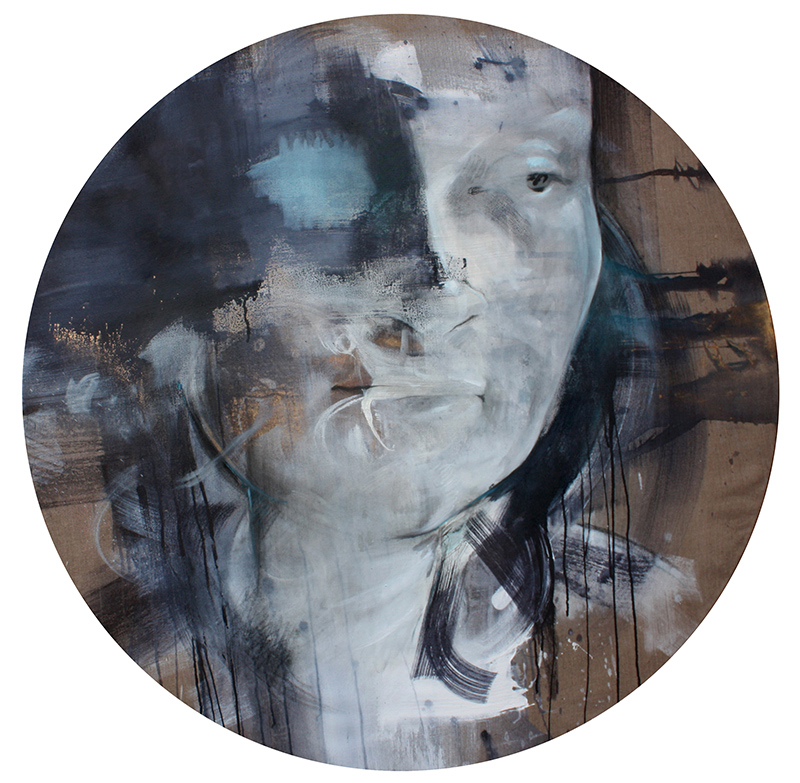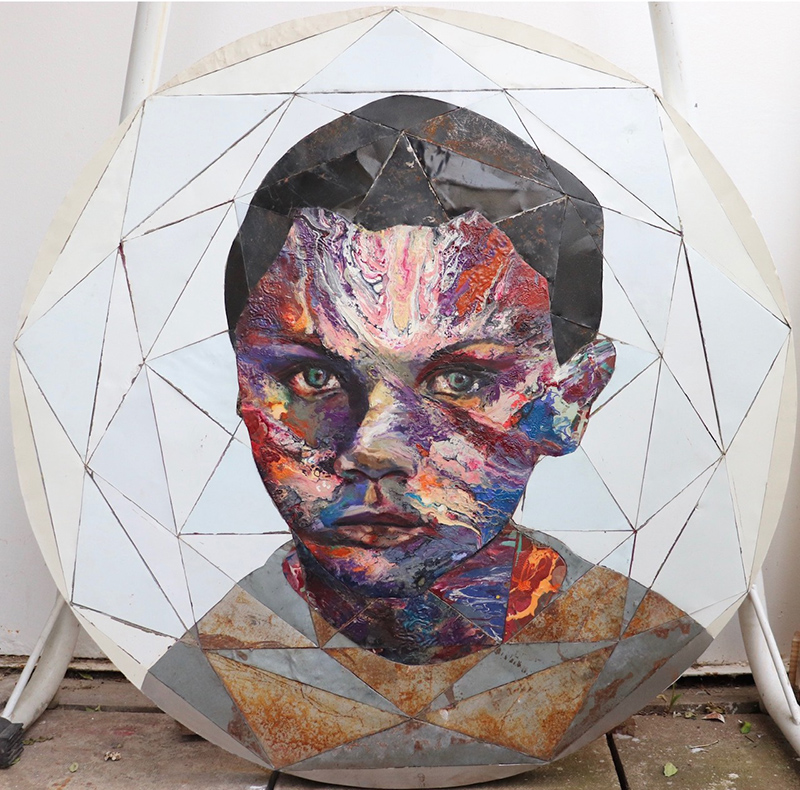






PORTRAITURE |
|
Portraiture in art is not only a form of representation, but also one of communication and interrogation. It may be suggested that the act of portraying through media including sculpture, and painting, merely depict the sitter and goes no further than a 2D/3D demonstration. However, through the exploration of artists such as Rebecca Fontaine-Wolf, Matt Small, Richard Chapman, and Suzie Zamit, I aim to address the poignancy of portraiture in challenging preconceived notions, ultimately forcing the viewer to question their assertions, and the sometimes unjust visions they project onto the sitter.
Fontaine-Wolf’s unconventional medium of painterly portraiture draws upon the highly complex, multi-layered personalities of the female psyche. Both the works title ‘Fragments of Self’ and the contorted depiction of the sitter deal with the challenging nature of self-worth/deprecation. The noun ‘fragment’ has connotations of being broken, or segregated from other parts of the self. Whilst the disjointed facial features, with the nose being the primary focus, imply a sense of disorderly chaos. Additionally, the lack of eyes on the face is symptomatic of a loss of identity and closure from the soul in which eyes are commonly seen as representative of the gateway to the soul, and an indicator of honesty.
|
 |
|
 |
Similarly, Fontaine-Wolf’s ‘Facing Evanescence’ focuses on the idea of intangibility of her sitter. The incorporation of ‘evanescence’ within the works title remarks on the impermanence of the sitter’s presence. The viewer has begun to develop a sense of intimacy and understanding between themselves and the subject, yet at the same time they are forbidden from ever really gauging the true identity and feelings of her. Similarly to ‘Fragments of Self’, facial features of the sitter are retreating into the abyss of the canvas, specifically the left side. The darker grey tones of the colour palette seem to be enveloping the white/purity of the sitter, destroying integral parts of her. The invasive grey against her face draws back to the sense of evanescence, bringing to the forefront ideas of mental deterioration, where the grey hue is particularly poignant around the eye/forehead region, an area associated with the brain. Again, Fontaine-Wolf closes the viewer off from her sitter, preventing any true narrative being forced upon them. This shows her as a woman in her own right, closing herself off from the troublesome patriarchal tendencies that manage to manifest themselves upon the portrayal of females.
|
|
|
An exceedingly special feature of portraiture, is the way in which it envelops the thoughts and feelings of the viewer, making them too a faction of the painterly technique. When we see a portrait the sitter is, more often than not, a stranger that we behold. We are unfamiliar with their characteristics and personality traits, yet, through representation, we feel it our right to project a persona and narrative upon them. Didier Maleuvre suggests that since the beginning of the Renaissance period, the nature of the portrait has shifted drastically from one that’s success would before have been measured by its likeness, to now one in which the ability to capture a sitter’s personality, and existence is fundamental to its prosperity.[1] In this way, it is not just the depiction by the artist of their sitter that is paramount to the way in which the viewer sees the image, but also the experiences and sentiments that the viewer brings to the canvas. |
||
|
Artist Matt Small deals with portraiture in a different way to Rebecca Fontaine-Wolf. His works are urban in their technique and colour palette, most often than not opting for an exuberant choice of colour palette. The works immediately have the capacity to draw the viewer in, gaining their attention from across the gallery or even, beyond it. Feeling neglected and unheard, the sitter is often young and disenfranchised from the system. The most poignant aspect of Small’s work is his choice of canvas, in which he opts for discarded objects including car bonnets and disused signposts. These once recycled components thrown away for their believed lack of future value have been reused by Small as a central part to his compelling and thought-provoking works. Like his canvases, Matt Small is giving his sitters a sense of purpose and identity. As the viewer, the beauty of the works is most poignant; seeing his subjects as a central component within this. Small’s work ‘Christopher’, depicted on a circular canvas displays a young boy as the primary focus. In contrast to other works in his portfolio, ‘Christopher’ is displayed against a white background, whilst his facial features are comprised of energetic painterly marks. His choice of a white backdrop is symbolic of the purity within the young boy, whilst the varied colour palette acts as a demonstration of his youthfulness and vigour. Due to the plenitude of marks on Christopher’s face, the viewer is encouraged to look beyond the two-dimensional image, and assess the various qualities that come to make up Christopher as a whole. Here, we do not see a young boy troubled and threatening, we see one desperately searching for connection with the green hue of his eyes beckoning solidarity and hope from his onlooker.
|
 |
|
|
In contrast to Fontaine-Wolf and Small, Suzie Zamit and Richard Chapman utilise the medium of sculpture to represent their sitters, and it is through this, that these portraits ensure ‘greater verisimilitude […] producing the quality of ‘breathing images’.’ Two sculptures of Zamits; ‘Alice’ and ‘Francis Bacon’, draw upon the idea of living images. Alongside the contrasting plaster colour of the two sculptures, the overall texture of them adds a sense of intimacy that is symptomatic of the subjects personality, and life experiences. |
||
|
|
 |
Scorned from his family home after being found in his mother’s attire, painter Francis Bacon had a challenging succession from adolescence into adulthood in a post-war world of deprivation. The accounts of rejection that he faced both from his familial bond, and the art world in which his first solo exhibition at Transition Gallery (1934) was harshly critiqued, are evident on the weathered face of Zamit’s Bacon bust. The toils faced by Francis Bacon, being a homosexual in a time in which it was still illegal, are carved into delicately sculpted areas of his face. The vacant stare of Bacon’s eyes suggest an air of impenetrability and darkness that often exudes from his own canvases. In juxtaposition, Suzie Zamit’s bust of her sitter, ‘Alice’, depicts a ballerina so brilliantly captured by the elegance of her smooth and supple features. Unlike Francis Bacon, her features appear untarnished by the harshness of daily life, leaving Alice with an ageless and youthful quality. The two busts are demonstrable of Suzie Zamit’s talent as a sculptor, in which she so powerfully has caught the moods and experiences of her models. In turn, she has projected said emotions onto the viewer, compelling them to question and delve deeper into the personas of Alice and Bacon, leaving us enticed. |
Left; Suzie Zamit | Alice Right; Suzie Zamit | Francis Bacon |
||
|
Having spent some childhood years in Zambia, Africa, it is clear to see how the ancient artistic traditions of the continent have infiltrated Richard Chapmans sculptural works, which pay homage to spirituality and Mother Earth. Chapman’s bust ‘Duku II’ identifies with his African origins in which the headscarf depicted is dressed in a pattern reminiscent of African Textiles. The sculpture’s title ‘Duku’, of African origin, means ‘to push’, and in this way brings to the foreground the force and strength of the female model. Her poise and bared muscles play into her physical strength with her stare so forceful, it compels the viewer to move closer. In this way, the viewer creates a persona for her that fit their perceptions of female identity. |
||
|
||
Left; Richard Chapman | Duku II Right; Richard Chapman | Harlequin II |
||
|
|
||
|
As we can see, the two features that contribute to the overall success of the portrait are the artist’s ability to capture their models personality and specific traits, as well as a likeness; and the experiences of the audiences that are too projected onto the work. Each of these artists, all represented by Gallery Different, have utilised their exceptional talent, initially to entice the viewer, and in time making them too, a subject of the work. All these works can be found in Gallery Different’s current Winter Collective exhibition, 2020.
|
||
| [1] Maleuvre, D. ‘Rembrandt, or the Portrait as Encounter’, Imaging Identity (Jstor) | ||